IVORY-BILLED WOODPECKER:
ONCE LOST, NOW FOUND
We first got wind of some earth-shattering nature news shortly after 3:30 p.m. on 27 April 2005 when a curious posting to the CarolinaBirds listserv entered our E-mailbox at Hilton Pond Center. The message referred to the BirdingAmerica.com Web site, on which Mary Scott that day had written the following cryptic message: "Soon, the Cornell Lab of Ornithology will be announcing that they have verified the existence of the Ivory-billed Woodpecker in Arkansas." Ms. Scott--a well-traveled, competent birder--claimed to have seen an Arkansas Ivory-bill in the spring of 2003, but her report apparently was dismissed by most folks as a misidentified, similar-looking Pileated Woodpecker. After all, the last confirmed and accepted sighting of an Ivory-bill in the U.S. had come 60 years ago, and the ornithological world in general had written off the species as extinct. Intensive efforts to find it in Louisana were unsuccessful, and most bird experts had given up hope for Ivory-bills unless there might still be a colony in the forests of Cuba. Nonetheless, we were more than a little intrigued by Mary Scott's cryptic comment, so we stayed glued to the Internet until wee hours of the morning, trying to glean tidbits of Ivory-bill information from various Web sites and listservs.
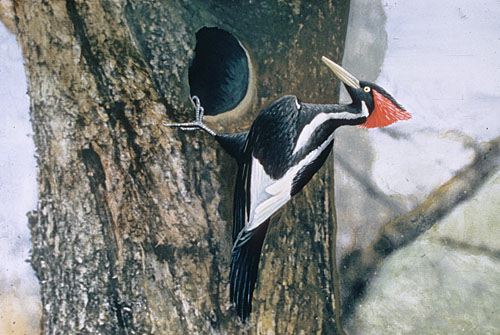
All text & photos © Hilton Pond Center
Colorized historical photo (above) by George Sutton © Cornell Laboratory of Ornithology
Finally, at about 2 a.m., we found a Cox News Service on-line article by Charles Seabrook that confirmed the unbelievable: "In news bound to electrify bird lovers worldwide, scientists are expected to announce today the 'rediscovery' of the Ivory-bill in a remote swampy area of northeast Arkansas known as the Big Woods. At least one male Ivory-bill has been found alive and well in the deep forest of bottomland hardwoods between Little Rock and Memphis. It is the first confirmed sighting of the long-sought bird since World War II." With that, we crawled off to bed but slept little; we were indeed electrified by a giant American woodpecker almost everyone thought was gone forever but was still in existence. The Ivory-billed Woodpecker, once lost, was now found.
It may be hard for a non-birder to understand the significance of the re-discovery of an Ivory-billed Woodpecker. In fact, a reporter from a local newspaper called us at Hilton Pond Center to get an explanation. The closest analogy we could conceive for her was that it was like having a long-lost grandfather suddenly show up alive and well after the family thought he had been dead for 60 years. The big difference, of course, is that Grandpa is an individual, and the passing of what was believed to be the last Ivory-bill in the 1940s meant that an entire SPECIES disappeared. Now, Ivory-bills had "come back from the dead" and birders are jubilant to know that for nearly six decades the third-largest woodpeckers in the world had somehow managed to survive undetected in an almost-impenetrable Arkansas swamp.
Our local newspaper ran the article about the Ivory-bill discovery--including a photo of a woodpecker along with our mug shot and quotes--so we weren't surprised to get several E-mails and phone calls from folks interested in the Arkansas sightings. 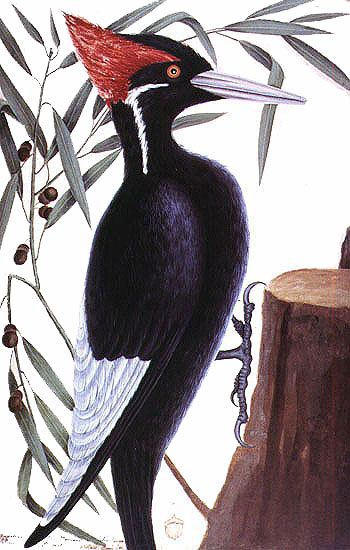 What was most interesting, however, was how many people contacted us with news they had seen Ivory-billed Woodpeckers in their own suburban backyards somewhere in the eastern U.S. Most callers seemed very disappointed when we patiently explained the Ivory-bill needs large expanses of old-growth timber and without doubt their sightings had been of Pileated Woodpeckers, not Ivory-bills. The misidentification IS understandable--to an inexperienced birdwatcher the two big woodpecker species look a lot alike--but in our judgment ANYONE should be perfectly happy with hosting a backyard Pileated even when it turns out NOT to be an Ivory-bill. What was most interesting, however, was how many people contacted us with news they had seen Ivory-billed Woodpeckers in their own suburban backyards somewhere in the eastern U.S. Most callers seemed very disappointed when we patiently explained the Ivory-bill needs large expanses of old-growth timber and without doubt their sightings had been of Pileated Woodpeckers, not Ivory-bills. The misidentification IS understandable--to an inexperienced birdwatcher the two big woodpecker species look a lot alike--but in our judgment ANYONE should be perfectly happy with hosting a backyard Pileated even when it turns out NOT to be an Ivory-bill.
What we know today as the Ivory-billed Woodpecker, Campephilus principalis, was first described and painted by Mark Catesby in about 1731 (above left). He called this bird the "Largest White-bill Wood-pecker, Picus maximus rostro albo," and wrote "The bills of these Birds are much valued by the Canada Indians, who made Coronets of 'em for their Princes and great warriors, by fixing them round a Wreath, with their points outward. The Northern Indians having none of these birds in their cold country, purchase them off the Southern People at the price of two, and sometimes three, Buckskins a bill." Obviously, the Ivory-bill had a survival problem even 300 years ago when these indigenous humans killed them just for their mandibles.
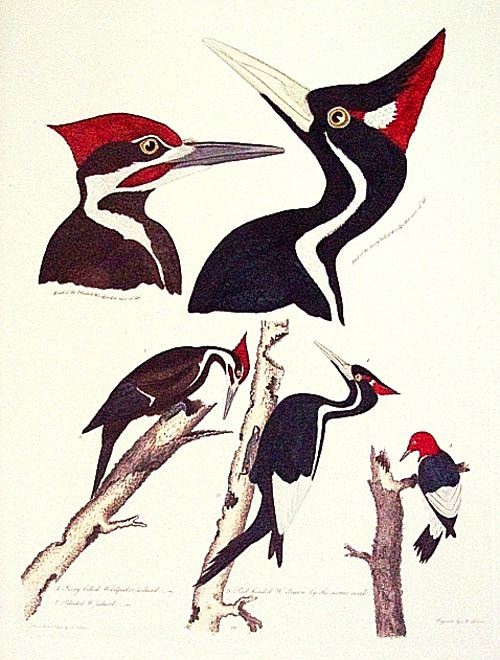
Early naturalist Alexander Wilson also encountered and painted the Ivory-bill in the 1790s; in the style of modern-day field guides he creatively rendered it on the same page as the Pileated Woodpecker (above). This provides us with excellent opportunity to compare the two species; in both, the males are basically black and white, with a red topknot. However, the male Pileated (above, left) has a red "moustache" and considerably more white on his face, while the Ivory-bill has darker cheeks and upper wings that are half black, half white. From the back the Pileated looks almost all black, while the Ivory-bill has a distinct white triangle where the tips of the wings touch. Wilson accurately depicted the Ivory-bill--18" long, with a three-foot wingspan--as being larger than the 15-inch Pileated and for an even better sense of scale included the much smaller Red-headed Woodpecker (7.5"). Wilson writes that he shot and slightly wounded an Ivory-bill that he then captured and placed in a hotel room, only to return an hour later to find the bird hammering the ceiling and wall to smithereens while trying to escape. Wilson then made the mistake of tethering his captive high-strung woodpecker to a mahogany table that, in short order, the big-billed bird nearly destroyed.
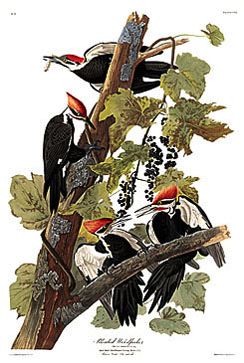 . . 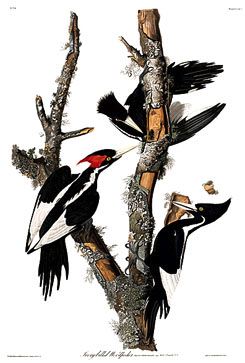
When John James Audubon came along in the early 1800s, he brought increased realism to bird paintings. His detailed illustration of a Pileated Woodpecker family (above left) shows that the female has a black--not red--moustache and that white in the wings of this species is limited to the front edge of the underwing. In Ivory-bills (above right) there is white on the trailing edge of the upper wing AND on both front and back edges of the underwing. Audubon correctly depicts the female Ivory-bill with a black crest that curls forward; the male's red topknot curls back. And lest we forget the obvious, the Pileated bill is shiny black, while the light-colored one of the Ivory-bill gives the bird its name.
It's worth noting that although the two woodpeckers depicted above by Audubon are similar in appearance, they aren't very closely related. In fact, they aren't just different species, but each is placed in a different genus: Campephilus principalis (Ivory-bill) and Dryocopus pileatus (Pileated). Since most hybrids in nature are between closely related species, it's highly unlikely there could ever be a fertile cross between these two big woodpeckers in different genera.
Although Pileated and Ivory-billed Woodpeckers were relatively common in the days of these Catesby, Wilson, and Audubon, both species began declining rapidly with the increase of human immigrants from Europe. Settlers in southeastern North American began a logging and land-clearing regimen that virtually eliminated large tracts of mature timber required by these large woodpeckers. When we learn that to meet the dietary needs of their offspring a pair of Ivory-bills must maintain a territory of up to six square miles containing enough recently dead big trees with just the right kinds of beetle grubs, we realize this species is so specialized that a major habitat disturbance is bound to affect it severely. 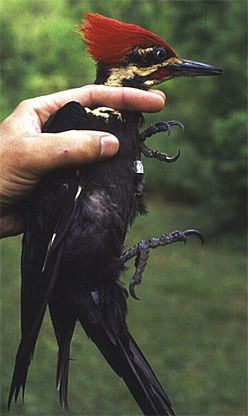 Pileateds, fortunately, are a little more general in their needs; we've seen their 3-inch diameter nest holes in such diverse South Carolina locales as a Palmetto tree on Edisto Island, a Loblolly Pine near center-city Columbia, and the dead snag of an American Sycamore here in York County. From this we conclude Pileateds occur in most of the major habitats in the state and seem to be able to coexist with people. Pileateds, fortunately, are a little more general in their needs; we've seen their 3-inch diameter nest holes in such diverse South Carolina locales as a Palmetto tree on Edisto Island, a Loblolly Pine near center-city Columbia, and the dead snag of an American Sycamore here in York County. From this we conclude Pileateds occur in most of the major habitats in the state and seem to be able to coexist with people.
We often encounter Pileated Woodpeckers while we're on trips in the eastern U.S.--usually when we're driving through a wooded area and a crow-sized bird with white in its wings flaps energetically across the road. We've seen the species at Hilton Pond Center a few times, but only once--on 30 April 1990 and almost 15 years to the day before the recent news of the Arkansas Ivory-bill--have we managed to capture one in a mist net (above left). That was an experience in itself, and we were particularly surprised when the adult male Pileated lay passively in the net as we extricated it. We thought this massive woodpecker would attempt to peck us to death, but he simply watched--and practically went to sleep in our hands--as we removed the mesh from his lengthy toes, placed a sizeable #4 aluminum band on his leg, and photographed him for posterity. 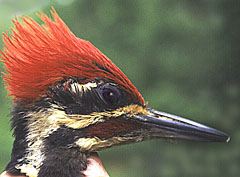 If all Pileateds are so low-key, perhaps this is one factor that allows them to survive despite human impacts while the high-strung, table-hammering Ivory-bill apparently needs to distance itself from people in remote areas such as the Big Woods of Arkansas. If all Pileateds are so low-key, perhaps this is one factor that allows them to survive despite human impacts while the high-strung, table-hammering Ivory-bill apparently needs to distance itself from people in remote areas such as the Big Woods of Arkansas.
We're extremely excited the "extinct" Ivory-billed Woodpecker has been re-discovered in the continental U.S. and that governmental and private agencies--particularly the Cornell Laboratory of Ornithology and The Nature Conservancy through the Big Woods Conservation Partership--have cooperated to find the bird and secure its current haunts. We doubt we personally will ever have opportunity to see a living Ivory-bill, but we take satisfaction in knowing that by setting aside Hilton Pond Center as a protected site, we're at least providing habitat where Pileated Woodpeckers could come to avoid the precarious existence faced by the once-lost, now-found Ivory-billed Woodpecker.
All text & photos © Hilton Pond Center
Comments or questions about this week's installment?
Please send an E-mail message to INFO.
NOTE: Be sure to scroll down for an account of all birds banded or recaptured during the week, as well as some other interesting nature notes.
"This Week at Hilton Pond" is written & photographed
by Bill Hilton Jr., executive director of
Hilton Pond Center for Piedmont Natural History.
You may wish to consult our Index of all nature topics covered since February 2000. You can also use the on-line Search Engine at the bottom of this page.
For a free, non-fattening, on-line subscription to "This Week at Hilton Pond," just send us an E-mail with SUBSCRIBE in the Subject line. Please be sure to configure your spam filter to accept E-mails from hiltonpond.org.
|


 What was most interesting, however, was how many people contacted us with news they had seen Ivory-billed Woodpeckers in their own suburban backyards somewhere in the eastern U.S. Most callers seemed very disappointed when we patiently explained the Ivory-bill needs large expanses of old-growth timber and without doubt their sightings had been of Pileated Woodpeckers, not Ivory-bills. The misidentification IS understandable--to an inexperienced birdwatcher the two big woodpecker species look a lot alike--but in our judgment ANYONE should be perfectly happy with hosting a backyard Pileated even when it turns out NOT to be an Ivory-bill.
What was most interesting, however, was how many people contacted us with news they had seen Ivory-billed Woodpeckers in their own suburban backyards somewhere in the eastern U.S. Most callers seemed very disappointed when we patiently explained the Ivory-bill needs large expanses of old-growth timber and without doubt their sightings had been of Pileated Woodpeckers, not Ivory-bills. The misidentification IS understandable--to an inexperienced birdwatcher the two big woodpecker species look a lot alike--but in our judgment ANYONE should be perfectly happy with hosting a backyard Pileated even when it turns out NOT to be an Ivory-bill.
 .
. 
 Pileateds, fortunately, are a little more general in their needs; we've seen their 3-inch diameter nest holes in such diverse South Carolina locales as a Palmetto tree on Edisto Island, a Loblolly Pine near center-city Columbia, and the dead snag of an American Sycamore here in York County. From this we conclude Pileateds occur in most of the major habitats in the state and seem to be able to coexist with people.
Pileateds, fortunately, are a little more general in their needs; we've seen their 3-inch diameter nest holes in such diverse South Carolina locales as a Palmetto tree on Edisto Island, a Loblolly Pine near center-city Columbia, and the dead snag of an American Sycamore here in York County. From this we conclude Pileateds occur in most of the major habitats in the state and seem to be able to coexist with people. If all Pileateds are so low-key, perhaps this is one factor that allows them to survive despite human impacts while the high-strung, table-hammering Ivory-bill apparently needs to distance itself from people in remote areas such as the Big Woods of Arkansas.
If all Pileateds are so low-key, perhaps this is one factor that allows them to survive despite human impacts while the high-strung, table-hammering Ivory-bill apparently needs to distance itself from people in remote areas such as the Big Woods of Arkansas.

 Please report your
Please report your
